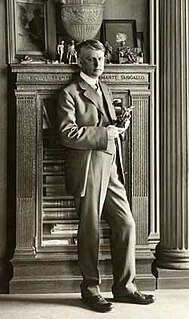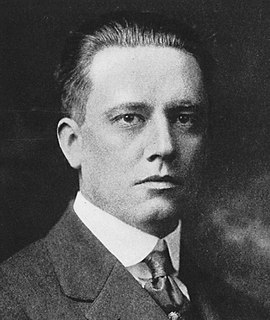Related Research Articles

Julia Morgan was an American architect and engineer. She designed more than 700 buildings in California during a long and prolific career. She is best known for her work on Hearst Castle in San Simeon, California.

Bernard Ralph Maybeck was an American architect in the Arts and Crafts Movement of the early 20th century. He was an instructor at University of California, Berkeley. Most of his major buildings were in the San Francisco Bay Area.

Thomas Dolliver Church was a 20th century landscape architect based in California. He is a nationally recognized as one of the pioneer landscape designers of Modernism in garden landscape design known as the 'California Style'. His design studio was in San Francisco from 1933 to 1977.

Joseph Esherick was an American architect.

Downtown Berkeley is a Bay Area Rapid Transit (BART) subway station located in Downtown Berkeley of Berkeley, California, United States, one of three stations in the city.

John Galen Howard was an American architect and educator who began his career in New York before moving to California. He was the principal architect at in several firms in both states and employed Julia Morgan early in her architectural career.

Willis Jefferson Polk was an American architect, best known for his work in San Francisco, California. For ten years, he was the West Coast representative of D.H. Burnham & Company. In 1915, Polk oversaw the architectural committee for the Panama–Pacific International Exposition (PPIE).
Samuel James Hume was an American dramatic director, producer, art museum director, and book dealer.

William Wilson Wurster was an American architect and architectural teacher at the University of California, Berkeley, and at the Massachusetts Institute of Technology, best known for his residential designs in California.
La Loma Park is a tract of land located in the Berkeley Hills section of the city of Berkeley, California in the San Francisco Bay Area. The Spanish word loma means "rise/low hill". It was the property of Captain Richard Parks Thomas, a veteran of the Civil War and Berkeley businessman. Today, it is entirely a residential area. Although hilly throughout, its average elevation is about 614 feet (187 m).

Ernest Born (1898−1992) was an architect, designer, and artist based in California. He and his wife Esther Baum Born (1902−1987) collaborated on diverse projects in the San Francisco Bay Area from 1936 on. She was also a notable architectural photographer.

Henry Clay Smith was an American architect.
Clarence William Whitehead Mayhew was an American architect best known as a designer of residential structures in the San Francisco Bay Area. Recognition came to him with a home designed in 1937 for the Manor family in Orinda, California; one which was included as an example of modern architecture's effect on the contemporary ranch house in California in several post-war published compilations of residential works.
Ernest Albert Coxhead (1863–1933) was an English-born architect, active in the United States. He was trained in the offices of several English architects and attended the Royal Academy and the Architectural Association School of Architecture, both in London. He moved to California where he was the semi-official architect for the Episcopal Church. At the beginning of his career, Ernest Coxhead focused on designing churches, primarily in the Gothic Revival style. After the mid-1890s, Coxhead focused on residential designs. He was involved in the emergence of the Arts and Crafts style in California. He succeeded in designing residences that incorporated the elements and character of the English country house - shingled, Arts and Crafts style English Vernacular Cottages that combined elements from different periods for dramatic effect.

Hart Wood (1880–1957) was an American architect who flourished during the "Golden Age" of Hawaiian architecture. He was one of the principal proponents of a distinctive "Hawaiian style" of architecture appropriate to the local environment and reflective of the cultural heritage of the islands. He was one of the three founders of the Honolulu Chapter of the American Institute of Architects, and the only one of its fourteen charter members to be elected a Fellow of the AIA. He served as territorial architect during World War II.
First Bay Tradition was an architectural style from the period of the 1880s to early 1920s. Sometimes considered a regional interpretation of the Eastern Shingle Style, it came as a reaction to the classicism of Beaux-Arts architecture. Its characteristics included a link to nature, and use of locally sourced materials such as redwood. It included an emphasis on craftsmanship, volume, form, and asymmetry. The tradition was rooted in San Francisco and the greater Bay Area. The Environmental Design Archives at the University of California, Berkeley house a repository of drawings and specifications associated with the tradition.

Emily Eolian Williams was a pioneering woman in architecture who was active in Pacific Grove, San Jose and San Francisco in the early 20th century, at a time, when very few women were able to enter the profession. She mainly designed houses, with conveniently planned interiors, and a few institutional buildings and an exhibition stand at the Panama-Pacific International Exposition in San Francisco.

Pedro Joseph de Lemos was an American painter, printmaker, architect, illustrator, writer, lecturer, museum director and art educator in the San Francisco Bay Area. Prior to about 1930 he used the simpler name Pedro Lemos or Pedro J. Lemos; between 1931 and 1933 he changed the family name to de Lemos, believing that he was related to the Count de Lemos (1576–1622), patron of Miguel de Cervantes. Much of his work was influenced by traditional Japanese woodblock printing and the Arts and Crafts Movement. He became prominent in the field of art education, and he designed several unusual buildings in Palo Alto and Carmel-by-the-Sea, California.

Edgar Asahel Mathews was an architect who worked in the Bay Area of California, particularly in San Francisco. He primarily designed houses but was also responsible for some Christian Science churches and commercial and government buildings.

Mark Roy Daniels (1881-1952) was an architect, landscape architect, civil engineer, and city planner active in California. He was known for creating plans that incorporated existing natural features in order to preserve a sense of local character. He worked on master plans for the development of neighborhoods in San Francisco and the East Bay, on the Monterey Peninsula, in Los Angeles, and elsewhere. In the years immediately preceding the formation of the National Park System, he was briefly the general superintendent and landscape engineer for the entire system of national parks under the United States Department of the Interior.
References
- ↑ "Finding Aid for the John Hudson Thomas papers" . Retrieved 7 January 2013.
- 1 2 "John Hudson Thomas". Archived from the original on 17 March 2016. Retrieved 7 January 2013.
- 1 2 Wilson, Mark A. (21 January 2007). "New Life for a Landmark". The San Francisco Chronicle. Retrieved 7 January 2013.
- ↑ "John Hudson Thomas". Archived from the original on 25 October 2018. Retrieved 7 January 2013.
- 1 2 "John Hudson Thomas - Self-Guided Tour of 7 Berkeley Houses (1979)" . Retrieved 7 January 2013.
- ↑ "Magnificent Hume Castle in Berkeley hits market at $5 million". 7 April 2016.